Phonological awareness, Letter knowledge
Children will understand the concept of a compound word. Children also will identify and name the letter A.


Review:
We are learning about compound words. Who would like to remind us what a compound word is? (a word made up of two words)
Today we are going to do something different with compound words. Each of us will get a card with a picture and a compound word on it. We will take turns saying the name of the picture on our card. Then we will try to figure out the two words that make up our compound word. Let me show you.
[Display the compound word card “butterfly.”]
What do you think is the compound word on my card?
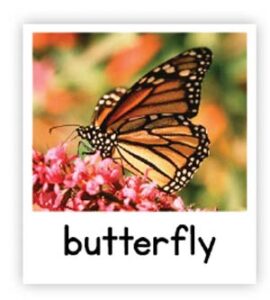 Yes! My compound word is butterfly. Let’s clap for each part of my compound word.
Yes! My compound word is butterfly. Let’s clap for each part of my compound word.
[Lead children in clapping two times as you say the word.]
We know that compound words are made up of two words. We need to decide which two words make up my compound word. I’ll say the word again. Let’s listen carefully for two different words when I say the compound word.
[Enunciate clearly when you say the compound word “butterfly.” Emphasize each component word.]
What is the first word you hear in the word “butterfly”?
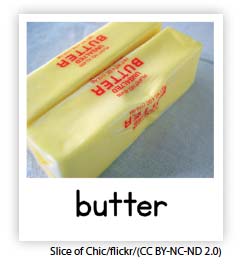
Yes. The first word is “butter.”
[Display the word card “butter.” Describe the picture on the card.]
Now listen carefully as I say the compound word again.
[Enunciate clearly when you say the compound word. Emphasize each component word.]
What is the other word you hear in “butterfly”?
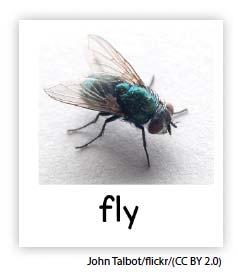
Yes. The last word is “fly.”
[Display the word card “fly.”]
When we put “butter” and “fly” together we make the word “butterfly.” “Butterfly” is a compound word!
Now we will each have a turn to figure out which two words we hear in a compound word.
[Give each child a compound word card.]
Look carefully at your compound word card. Ask me or your neighbor to help you if you do not know the picture shown on your word.
[Use the procedure demonstrated on the previous page to help each child identify the two words in his/her compound word. If other children know the words that comprise a child’s compound word, remind them to think of the words in their head rather than say them out loud. This way each person will get a turn to determine the two words in their own compound word.]
Today we are going to learn a different letter of the alphabet.
[Display letter A card.]
Does anyone know the name of this letter?
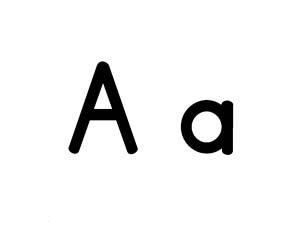 This is the letter A. We can write the letter A in two ways. We can write the letter A like this.
This is the letter A. We can write the letter A in two ways. We can write the letter A like this.
[Demonstrate writing an uppercase A at the top of a chart paper.]
This is an uppercase A.
We can also write the letter A like this.
[Demonstrate writing a lowercase a at the top of a chart paper.]
This is a lowercase a.
We are learning about letters of the alphabet. We know that the alphabet contains all the letters we use to write words. Alphabet is a word that starts with the letter a. I will write this word on our chart. I am going to write the word “alphabet” with a lowercase (small letter) a.
[Say each letter as you write the word. Emphasize a.]
Let’s all say the word “alphabet.”
[Invite a volunteer child to point to the letter a at the beginning of the word “alphabet.”]
Let’s look at the very first letter of our name. Pop up if you have the letter A at the beginning of your name. Remember, names begin with an uppercase (big) letter.
[Encourage children to look at their name cards. Say the first names of children who have an A at the beginning of their name. If there are children whose name begins with the letter A who do not stand, point to the letter A on their name card. Compare the letter A in their name as you hold the letter A card next to their name card.
If no one in the group has a first name beginning with the letter A, say “No one popped up because no one has a name that starts with the letter A.” Encourage children to look at the list of children’s first names. Point to some first letters of names. Explain that no one’s name begins with the letter A.
If a child indicates there is a letter A in his/her name, but not at the beginning of the name, fully recognize the name and invite the child to pop up. Day 4 gives attention to the letter a that appears somewhere else in a child’s name.]
Today we listened for the two words that are in a compound word. We tried this with different compound words. Let’s together try to hear two words in another compound word. The compound word is popcorn. Pop up if you can name both words in the compound word popcorn! What are the two words? Yes! We hear the words “pop” and “corn” in the word popcorn. Popcorn is a compound word.
We also learned about the letter A. What is a word that begins with the letter a? (alphabet, perhaps the name of a child in your group)
Extra support
Enrichment
| footprint | nametag | raindrop | stomachache |
|---|---|---|---|
| baseball | sweatshirt | headphone | restroom |
Place *compound word cards in a basket. Invite children to choose a card, say the word, and then decide which two words they hear in the compound word. Invite children to then draw a picture for each part of the compound word. Example: starfish—the child would draw a star and a fish.
*Printables provided
Practice segmenting compound words during outside playtime. Invite school-age children to say a compound word and ask younger children to jump each time they say one of the two words that make up the compound word.
Geometric and spatial knowledge
Children will understand that basic shapes can be different sizes.


New:
Be Prepared: For the shape sorting task in this activity, secure an extra cutout or draw an illustration of each of the following: circle, rectangle, square, triangle.
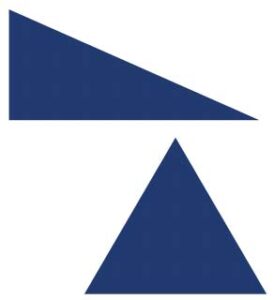 We know that triangles can look different. Some triangles have longer sides or different corners than other triangles.
We know that triangles can look different. Some triangles have longer sides or different corners than other triangles.
[Display two triangles of different types.]
Are these both triangles? How do we know? (both have three sides and three corners)
Shapes can also come in many different sizes. The size of something is how big it is. Let’s look at some rectangles, squares, and circles of different sizes.
 [Display three rectangles of different sizes.]
[Display three rectangles of different sizes.]
Now let’s look at some squares.
 [Display three squares of different types.]
[Display three squares of different types.]
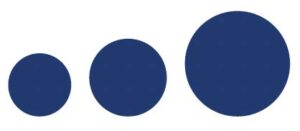 [Point out that as each square gets bigger, it still has equal sides.
[Point out that as each square gets bigger, it still has equal sides.
Display three circles of different sizes.]
Now let’s look at two rectangles in different ways.
[Display two rectangles of the same size.]
 If I lay one rectangle on its side and stand the other rectangle up tall, are they still both rectangles? (Yes, they are! A rectangle is still a rectangle even when it is on its side or standing up tall!)
If I lay one rectangle on its side and stand the other rectangle up tall, are they still both rectangles? (Yes, they are! A rectangle is still a rectangle even when it is on its side or standing up tall!)I am going to lay all of our shapes on the floor. Then we will sort the shapes into baskets. We will have a basket of squares, a basket of circles, a basket of triangles, and a basket of rectangles.
Today we learned that shapes can be different sizes. We also sorted different shapes into baskets. Who can describe a triangle? How about a rectangle? What does a shape need in order to be a square? How about a circle?
Extra support
Enrichment
Provide pipe cleaners. Invite children to make various shapes with the pipe cleaners. Provide basic shape cutouts for children to use as a reference.
Take children on a shape walk through the house. Invite them to find things that are in the form of a basic shape or find shapes you name.
Inquiry skills
Children will understand how to use a magnifying glass.


New:
Review:

We are learning that scientists can use tools to learn more about something. Remember, a tool is an item that helps us do something.
Scientists can use tools to look at something closely. Today we are going to learn about a tool that helps us to observe something closely.
[Hold up a magnifying glass.]
Do you know the name of this tool?
This is a magnifying glass. A magnifying glass helps us observe something by making it look larger.
Have you ever used a magnifying glass?
[Encourage children to describe experiences with a magnifying glass.]
A magnifying glass helps us learn more about what something looks like.
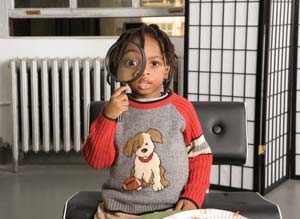 [Demonstrate how to use a magnifying glass while looking at a plastic insect. Describe details you are better able to see.
[Demonstrate how to use a magnifying glass while looking at a plastic insect. Describe details you are better able to see.
Continue the activity by looking at ice cubes, using the plan offered below. An alternative is to give a magnifying glass to each child and encourage him/her to explore using the tool by looking at different things in the classroom. This alternative option is especially appropriate if children have limited experience with a magnifying glass.]
Do you remember how we observed ice cubes several weeks ago? We learned the ice cubes were cold, hard, and wet.
We are going to observe ice cubes again. This time we will use a magnifying glass to observe the ice cubes.
[Give each child an ice cube in a bowl and a magnifying glass. Encourage children to look at the ice cube using the magnifying glass.]
What do you see when you use the magnifying glass to look closely at your ice cube? (it has little cracks, bubbles, etc.)
Let’s put some salt on our ice cubes and use our magnifying glasses so we can observe them more closely.
[Assist children in sprinkling salt on their ice cube.]
[Encourage children to use the magnifying glasses to observe the ice cube with salt on it. Children are likely to see little holes in the ice from the salt.]
Let’s compare looking at the ice cubes with a magnifying glass and looking at the ice cubes without a magnifying glass. Remember, when we compare things we look for ways they are the same and different.
We can see more things when we use the magnifying glass. A magnifying glass makes things look larger.
A magnifying glass is a tool we can use to observe something more closely. Our ice cubes looked larger when we observed them with a magnifying glass.
Extra support
Enrichment
Provide several items to observe and magnifying glasses. Encourage children to look for details in each item. Ask children questions as they observe. Examples: “What do you see when you use the magnifying glass?” “Can you still see it without the magnifying glass?”
If a magnifying glass is not available for each child, encourage children to take turns using what is available. Invite children to look at an item and describe what they see.
Understanding Feelings
Social-Emotional
Skill and Goal
Emotion knowledge
Children will understand there are many kinds of feelings.
Materials
Needed
*Printables provided
Key
Concepts
New:
Also
Promotes
We are learning that we can be the same and different in how we look and what we like to do. We can also be the same and different in how we feel on the inside. Another word for how we feel on the inside is emotion. An emotion is a feeling.
Happy is an emotion. When we are happy, we feel good inside and we might have a smile on our face.
What are some things we do in our classroom that might make us feel happy?
We can have different kinds of feelings. And, people can feel different ways about the same thing. Let’s imagine that a dog is going to visit our classroom. Some of us might feel happy inside because we like dogs. Some of us might have a different feeling about a dog visiting our classroom. We might feel scared or frightened.
We will read a book today that tells us about different kinds of emotions. The book is called The Way I Feel. The author of the book is Janan Cain. She is also the illustrator.
Here is a poster that has a face for each emotion described in our book. Let’s look at the faces in our poster.
[Display Our Feelings poster. Discuss each face and its corresponding emotion. Invite children to make a face like the one depicted in the picture. Hang the poster in a prominent place in the classroom. Draw children’s attention to the location of the poster.]
[If time permits, use your face to convey some of the emotions discussed in this activity and encourage children to guess the feeling your face is showing.]
Scaffolding Tips
Extra support
Enrichment
Center Activity
Provide The Way I Feel by Janan Cain and small, non-breakable hand mirrors. Encourage children to make the faces they see in the book.
Family Child Care
As you read The Way I Feel by Janan Cain, encourage school-age children to describe a time they may have felt the pictured emotion.